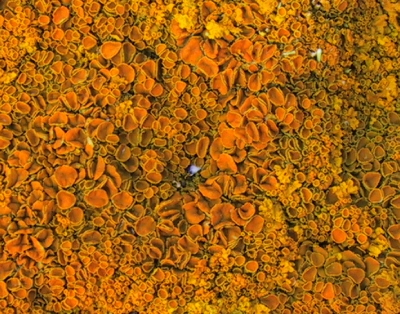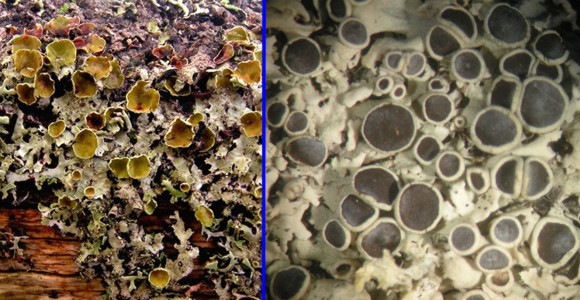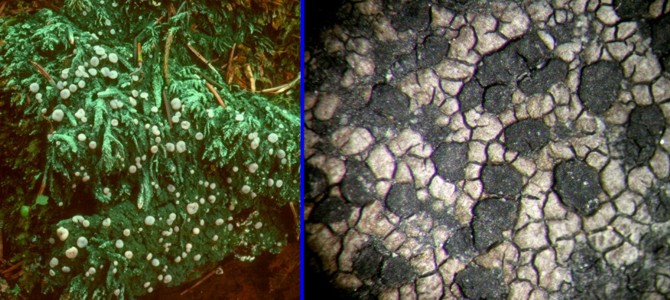Home >> Diversity and classification >> True fungi >> Dikarya >> Ascomycota >> Discomycetes >> Lichen-forming Discomycetes
THE LICHEN-FORMING DISCOMYCETES

The lichen-forming discomycetes are members of the class Lecanoromycetes and are quite distantly related to other discomycetes. It is not usually difficult to separate members of this group from other discomycetes because of their nearly universal occurrence in lichen associations. If you find one and it is not obviously part of a lichen you may still need to confirm your identification. Some species either produce such an obscure thallus that you will not see it easily or they may occur as parasites on other lichen-forming fungi. In the former case you will usually be able to find some clusters of algae in a microscopic mount but if it is parasitic it may be necessary to examine the asci closely to confirm the presence of a thickened apex. The fungus at left, Xanthoria parietina, provides a good example of this process. Although its apothecia are an orange colour this is not unusual among non-lichenized discomycetes. However, the paler orange lobes of the thallus give it away immediately as one of the Lecanoromycetes. A further examination with a microscope would reveal abundant algae, thickened asci and peculiar ascospores.Its occurrence on bare rock would be a further clue that it is not a saprotrophic fungus.

Parmelia squarrosa and Phaeophyscia ciliata, two bark-inhabiting members of the order Lecanorales, have apothecial characteristics that are common to many species in this group. Particularly obvious in P. ciliata is the pale apothecial rim or margin. In this species the thallus (the main body of the lichen) continues up around the outside of the apothecium to form what lichenologists call a thalline or lecanorine exciple, that is a layer containing both fungal and algal cells. It is less noticible in the picture of P. squarrosa because it is at a lower magnification but it still can be seen, especially in the very young apothecia. The green colour inside the apothecia is due to the algae in the exciple showing through the layer of asci.

Many lichens have apothecia without a lecanorine exiple. In these fungi the apothecia are composed entirely of fungal tissue and will not contain any algae at all. The picture at left shows two such species, Icmadophila ericetorum at far left and Rhizocarpon concentricum at near left. Icmadophila ericetorum has what is called a biatorine exciple, one in which the outer layers of the apothecium are light-coloured and contain no algae. The exciple of R. concentricum also lacks algae but is characterized by a very dark outer layer that appears to be quite black in the picture. This type is called a lecideine exciple. Note that the upper layer of the disk is also black and hardly distinguishable from the exciple. Rhizocarpon distinctum usually grows on rocks in very exposed sunny places and probably benefits from the filtering effects of the dark pigments. The terms lecanorine, biatorine and lecideine may seem to be difficult to pronounce and rather abstruse at first but are quite intuitive once you begin to study lichens. They are based on the common genera Lecanora, Biatora and Lecidea. Particularly good examples of these exciple types can be found among the species of these genera. The entirely black apothecia of Rhizocarpon distinctum hardly look as though they have an exposed layer of asci, but a cross-section with a sharp razor will reveeal that they do. Similar lichens (and non-lichens) with a permanently covered surface and no clearly distinct excipulum could be members of the Arthoniales.